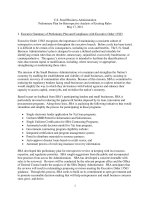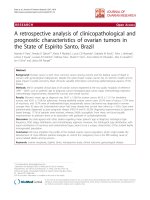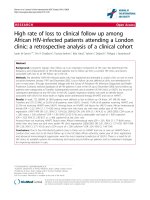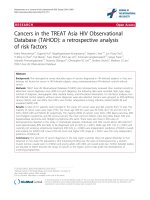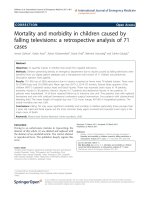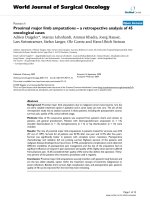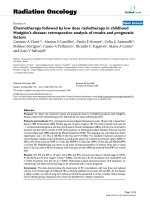retrospective analysis of management of ingested foreign bodies and food impactions in emergency endoscopic setting in adults
Bạn đang xem bản rút gọn của tài liệu. Xem và tải ngay bản đầy đủ của tài liệu tại đây (651.37 KB, 5 trang )
Geraci et al. BMC Emergency Medicine (2016) 16:42
DOI 10.1186/s12873-016-0104-3
RESEARCH ARTICLE
Open Access
Retrospective analysis of management of
ingested foreign bodies and food
impactions in emergency endoscopic
setting in adults
Girolamo Geraci* , Carmelo Sciume’, Giovanni Di Carlo, Antonino Picciurro and Giuseppe Modica
Abstract
Background: Ingestion of foreign bodies and food impaction represent the second most common endoscopic
emergency after bleeding. The aim of this paper is to report the management and the outcomes in 67 patients
admitted for suspected ingestion of foreign body between December 2012 and December 2014.
Methods: This retrospective study was conducted at Palermo University Hospitals, Italy, over a 2-year period. We
reviewed patients’ database (age, sex, type of foreign body and its anatomical location, treatments, and outcomes
as complications, success rates, and mortalities).
Results: Foreign bodies were found in all of our 67 patients. Almost all were found in the stomach and lower
esophagus (77 %). The types of foreign body were very different, but they were chiefly meat boluses, fishbones
or cartilages, button battery and dental prostheses. In all patients it was possible to endoscopically remove the
foreign body. Complications related to the endoscopic procedure were unfrequent (about 7 %) and have been
treated conservatively. 5.9 % of patients had previous esophageal or laryngeal surgery, and 8.9 % had an underlying
esophageal disease, such as a narrowing, dismotility or achalasia.
Conclusion: Our experience with foreign bodies and food impaction emphasizes the importance of endoscopic
approach and removal, simple and secure when performed by experienced hands and under conscious sedation
in most cases.
High success rates, lower incidence of minor complications, reduction of the need of surgery and reduced
hospitalization time are the strengths of the endoscopic approach.
Keywords: Upper endoscopy, Foreign body, Food bolus impaction, Endoscopic management
Background
Foreign-object ingestion and food-bolus impaction are
common occurrence in the emergency endoscopy. They
represent a significant clinical problem, causing a high
degree of financial burden, morbidity and mortality, and
pose diagnostic and sometimes therapeutic challenges.
In adults, foreign-object ingestion or insertion occurs more
commonly among those with psychiatric disorders or
mental retardation, as well as food impactions or impairment occurs more commonly in subject with
previous upper laryngeal or gastrointestinal surgery and
in case of altered esophageal motility [1–3]; moreover,
their management depend on a number of factors, such
as anatomic location, shape and size of the foreign
body, and duration of impaction [1].
The aim of our retrospective study is to report our experience and outcome in the management of 67 consecutive cases of ingestion of foreign bodies or food impactions
in a University Hospital with emergency endoscopy setting.
* Correspondence:
Operative Unit of General and Thoracic Surgery, University of Palermo,
Palermo, Italy
© The Author(s). 2016 Open Access This article is distributed under the terms of the Creative Commons Attribution 4.0
International License ( which permits unrestricted use, distribution, and
reproduction in any medium, provided you give appropriate credit to the original author(s) and the source, provide a link to
the Creative Commons license, and indicate if changes were made. The Creative Commons Public Domain Dedication waiver
( applies to the data made available in this article, unless otherwise stated.
Geraci et al. BMC Emergency Medicine (2016) 16:42
Methods
Data collection
Sixty-seven consecutive patients (27 % of 241 consecutive
admissions, 50 male and 17 female, mean age 47 years,
range 19–62 years, median age 53 years) with a recent history of foreign body ingestion or food bolus impaction
were admitted over a 2-year period between December
2012 and December 2014, from the Emergency Room to
the Emergency Digestive Endoscopy Service of University
Hospital “Paolo Giaccone” in Palermo.
Page 2 of 5
We used flexible endoscopes (GIF-Q145, GIF-Q165
and GIF-Q180; Olympus Optical Co, Ltd, Hamburg,
Germany) and accessories used to remove the foreign
bodies included snares, forceps and retrieval basket.
Demographic and endoscopic data, including age, sex,
referral sources of patients, types, number, and dimension
and location of foreign bodies or food bolus impacted,
associated upper-GI disease, endoscopic methods and
accessory devices for removal of foreign bodies or food
bolus were retrospectively collected and analyzed (Table 1).
The patients were observed until hospital discharge.
Clinical practice
A previous clinical history of foreign body ingestion was
present in six cases (9 %).
Forty-three patients referred no comorbidities related
to altered transit; whereas, schizophrenia was reported
in 1 patient, esophageal narrowing in 2, esophageal dismotility in 2, achalasia in 2, previous laryngeal surgery
(tracheostomy tube) in 2, previous esophageal surgery in
1 and drug addiction in 14 patients.
Nineteen patients (28.79 %) were asymptomatic, while
43 patients (65.15 %) referred dysphagia, 12 (18.18 %)
nausea, 9 (13.6 %) salivation, 7 (10.6 %) drooling, 6 (9 %)
vomiting, 1 (1.5 %) gastric outlet obstruction and 1
(1.5 %) sense of lump behind the sternum.
The clinical suspect was supported by radiographic
findings in 48 cases (72 %), performed within 5 h form
diagnosis (plain radiography of the abdomen in 34
cases = 70 %, plain radiography of the neck and chest in
11 cases = 23 %, CT in 9 = 18 %, and abdominal ultrasound
in 3 cases = 6 %) and always before endoscopy, also to rule
out the suspicion of perforation.
In 17 cases (25.3 %) the ingestion was voluntary.
All patients were asked to give their informed consent
and no one refused (the patients with psychiatric disturbance received consent from legal guardian).
All patients received emergency upper endoscopy within
6 h of ingestion and were followed until elimination or
removal of the foreign objects.
The endoscopies were all performed by two endoscopic
surgeon, in collaboration with a specialized nurse and an
anesthesiologist.
The procedure was performed under local pharyngeal
anesthesia (Lidocaine chloridrate spray 10 % 10 gr/100 ml,
Molteni Farmaceutica, Firenze, Italy) and a combination
of midazolam and fentanyl, on escalating dosing according
to the needs for conscious sedation in 51 cases (75 %); 16
patients (25 %) refused sedation.
The patients with psychiatric disturbance underwent
the same type of analgosedation.
The procedures were conducted under heart rate, oximetry and and blood pressure monitoring and supplemental oxygen was given through nasal mask during the
entire procedure.
Statistics
All data correspond to a normal Gaussian distribution,
according to tests performed before and after data collections (the value of mean corresponds to the value of
the median, and asymmetry is 0.51, between the value
of −2 to +2).
GG and GCD reviewed and collected all patients’ files
from intranet hospital database with full notations on the
following data: age, sex, type of foreign body, its anatomical location, treatments, and outcomes (complications,
success rates, and mortalities); GG and CS reviewed the
charts and a third blind observer (statistical doctor) confirmed correct data extraction and entry.
Our study received approval by the Institutional Ethic
Committee of Faculty of Medicine.
Results
The foreign bodies have been identified through upper
endoscopy in all 67 patients referred to us because of
suspected foreign-body ingestion.
The types of foreign bodies found in the upper-GI
tract varied greatly, including in order of frequency, foodbolus impactions (17 patients), fish bones (8 patients),
button battery (8 patients), chicken bones (5 patients),
dental bridge (4 patients), razor blades (3 patients),
glass fragments (3 patients), cocaine packs (3 patients),
nails (3 patients), coca cola tabs (3 patients), piercing (2
patients), seeds fruit (2 patients), fishing hook (2 patients),
hairpin (2 patients), rings (1 patient) and head of octopus
(1 patient).
Fish and chicken bones and dental prostheses were the
most common foreign bodies elderly people.
The foreign bodies were located more frequently in
the lower esophagus (27 patients = 40.5 %) and in the
stomach (27 patients = 40.5 %), followed by upper esophagus (4 patients = 6.06 %), duodenum (4 patients = 6.06 %),
larynx (2 patients = 3.04 %), ipopharynx (2 patients =
3.04 %) and oropharynx (1 patient = 1.5 %).
The most common foreign bodies in the pharynx and
the operated pharynx (also with tracheostomy tube)
were bones and food-bolus impactions, respectively. Fish
bones, food bolus, and dental prostheses were the most
Geraci et al. BMC Emergency Medicine (2016) 16:42
Page 3 of 5
Table 1 Type and localization of foreign bodies (also contemporary)
common foreign bodies in the esophagus, whereas button
batteries and dental bridge were frequently located in the
stomach. In the duodenum, the foreign bodies that had
passed through the stomach were small and smoothly
shaped objects, such as piercing and little cocaine pack.
Method and technique of upper endoscopy
The endoscopic methods varied according to the types of
the foreign bodies and the more frequently used accessory
devices were retrieval Dormia basket (57 %) followed by
rat-tooth foreign bodies forceps (24 %) and snare (19 %).
Dormia basket was the preferred method to retrieve
button batteries (100 %), piercing (100 %), glass fragments
(100 %).
Pulling with a rat-tooth forceps was the most effective
method to extract the chicken and fish bones (100 %).
Snares were most frequently used in dealing with the
ingested dental prostheses. Large or small food bolus, after
fragmentation, were gently pushed into the stomach or
intestine by gentle pressure with the endoscope on the
center of the bolus.
A latex protector hood or an overtube was used to
protect the esophageal mucosa during procedure.
In summary, we performed endoscopic extraction in
49 cases (73 %) and dislodgement in 18 (27 %).
There was no mortality associated with the endoscopic
procedures of removing foreign bodies in our center
over the past 2 years. The complications of the endoscopic
procedure included mucosal laceration (5 cases = 7.5 %)
and fever ≤38 °C (4 cases = 6 %).
Mucosal laceration were immediately treated by endoscopy clipping without further morbidity, and the patients
with fever were recovered after administration of broad
spectrum antibiotics for 2 days.
Discussion
Foreign-object ingestion and food-bolus impaction are
common occurrence all over the world: 80 to 90 % of
foreign bodies ingested have been reported to pass harmlessly and spontaneously through the GI tract, although
approximately 1500 deaths per year have been attributed
to foreign-body ingestions in the USA [1, 4]; in Italy
Geraci et al. BMC Emergency Medicine (2016) 16:42
the overall incidence is about 450 new cases/year (60 %
in children <4 years) [2, 3].
Nevertheless, mortality rates have been extremely low:
a compilation of multiple studies including 2 large series
report no deaths in 852 adults and 1 death in 2206
children [5].
The mortality associated is really unknown [5], nevertheless it is very low because of the high rate of early
and resolutive endoscopic removal (63-76 %) [5], as well
as the rate of spontaneous passage, without intervention
or any damage of gastrointestinal tract, was related to
the size and the type of foreign bodies (it has been suggested by the ASGE that only 10 to 20 % of foreign
bodies may need to be removed endoscopically) [5, 6].
Since the first report in 1972 on the endoscopic removal of a foreign body [7] there has been an increasing
request of endoscopic maneuvers, because of avoidance
of surgical removal for most patients reduced cost; besides, endoscopic removal is characterized by technical
facility, excellent visualization, simultaneous diagnosis of
other diseases, and a low rate of morbidity [5].
Direct radiographs may identify most radiopaque foreign bodies but not food bolus impaction; in addition,
fish or chicken bones, wood, plastic, most glass, and thin
metal objects are not readily seen [5].
Swelling, erythema, tenderness, or crepitus in the neck
region may be present with oropharyngeal or proximal
esophageal perforation and the abdomen should be
examined for evidence of peritonitis or signs of obstruction; these conditions will require surgical intervention and consultation should not be delayed for
endoscopy [8].
The increased salivation, as in our cases, is a sign of
proximal esophageal obstruction (9 cases = 13.6 %) [7],
and may lead to early endoscopy, while dislodgment of
the fleshy meat bolus from the esophagus was achieved
by gentle pressure with the endoscope on the center of
the bolus [9].
Nevertheless, in clinical endoscopic practice, if the risk
of esophageal perforation and bleeding is high, as in
those cases with sharpened or pointed foreign bodies
deeply fixed into the wall, it is better to avoid any endoscopic attempts and to resort to surgery [6].
The open safety pin always represented a major problem:
if a safety pin is in the esophagus with the open end proximal, it is best managed with the flexible endoscope by
pushing the pin into the stomach, turning it, and then
grasping the hinged end and pulling it out first. The use of
overtube makes easier the extraction. The ingested razor
single-edge blade is also a traumatic experience for both
the patient and the endoscopist, but it can be managed
with the flexible endoscope and overtube, especially if it
has reached the stomach. One also can use a rubber
hood or a self made piece of rubber glove (finger glove)
Page 4 of 5
on the tip of the endoscope to protect the esophagus
from sharp or pointed foreign bodies. Once a razor
blade has negotiated the stomach, surprisingly, it will
usually pass through the lower gastrointestinal tract
without difficulty [10].
Sites of trapped foreign bodies or food bolus may be
related to at least three factors: anatomical (narrowest
areas as upper esophagus, were a common site, especially
in the elderly with neurological deficits); pathological
(acquired strictures); and the nature of foreign body:
sharp pins were mostly seen piercing the antrum. This,
in turn, determined the tools to be used in removal:
lodged foreign bodies or food impaction were grasped
by forceps while in the stomach, it was easy to use the
snare or to open and close the basket [9].
Most ingested foreign bodies (80–90 %) pass through
the GI tract spontaneously, 10 to 20 % need endoscopic
intervention, and only 1 % or fewer may require surgery
[4, 11]: objects larger than 2 cm in diameter may lodge
at the pylorus, whereas objects longer than 6 cm may
become entrapped either at the pylorus or at the duodenal C-curve, between the first, second and third part
of the duodenum, and rarely pass beyond that point [3];
besides, a large foreign body, occluding the visceral lumen,
may lead to severe symptoms and even death, whereas a
small foreign body should be asymptomatic, apart from a
recent history of foreign body ingestion [4, 9].
The size, shape, and classification of the ingested
material, the anatomic location in which the object is
localized and, finally, the endoscopist’s skill influence
the management and practice at grasping a identical or
similar object with the available instruments outside
the patient may be beneficial [9, 12].
Overtube offers airway protection during retrieval, allows for multiple passes of the endoscope during removal
of multiple foreign bodies or a food impaction, and may
protect the esophageal mucosa from lacerations during
retrieval of sharp objects [4, 13].
If the foreign body becomes impacted in the esophagus,
it may cause serious sequelae such as esophagitis, mucosal
ulceration and hemorrhage, obstruction, perforation, or,
rarely, death [11].
Significant factors that might predispose patients to
complications include delayed presentation (≤24 h after
the onset of symptoms), presence of a sharp foreign
body, mental illness, wearing dentures, and multiple objects. A high index of suspicion, judicious judgment, and
early endoscopic intervention within 24 h after ingestion
are associated with favorable outcomes [11].
Likewise, we found that about 58 % of our patients had
an impaction in the esophagus, and for this reasons,
physicians should examine this organ more carefully
both to identify the foreign body and to assess the condition of the mucosa [9].
Geraci et al. BMC Emergency Medicine (2016) 16:42
Because of the ingestion is often in proximity to a
meal, the risk of aspiration should be assessed, and the
ventilation and the airway should be secured, also with
tracheal intubation, if necessary [5].
From what was previously written, it is clear that experienced endoscopists and well-equipped theaters are
required to perform these maneuvers [5].
In our experience, according to international indications, the endoscopic procedure was performed in most
of the patients within 6 h, because the foreign bodies
had not passed through the upper-GI tract.
Conclusions
Ingestion of foreign bodies is a worldwide common clinic
problem and an endoscopic conservative approach should
be shortly always performed for its excellent success rate
(≥90 %) and lower failure rate or minor complication.
Our experience with endoscopic foreign body removal
emphasizes its importance and ease when performed by
experienced hands with tailored approach, at well-equipped
endoscopy units, and under conscious sedation in most
cases, with high success rates and minor complications.
However, majority of cases can be successfully managed
conservatively.
In our experience, in accord to international literature,
surgery is required only in selected patients with high
risk of esophageal perforation or after removal failure of
sharpened objects.
Acknowledgements
Not necessary.
Funding
Not applicable (no funding were have been requested or obtained).
Availability of data and materials
All data presented in the manuscript are registered and available from the
print and media database of General Surgery and Emergency Department of
the School of Medicine of Palermo.
Authors’ contributions
GG conceived and deviced the manuscript. GG and GDC collected the cases
and iconography. GG and CS performed statistic analysis. GG, CS, AP and GM
written the manuscript. GG, GDC, CS, AP and GM revised the manuscript,
agreed on its conclusions and approved the final version of the manuscript.
Competing interest
The authors declare that they have no competing interests.
Consent for publication
Not applicable (the manuscript do not contain individual data but only
cumulative data; however, the Ethic Committee approved this retrospective
study).
Ethics approval and consent to participate
This retrospective study received approval by the Institutional Ethic Committee
“PALERMO I” of University Hospital of Palermo (protocol number 15EC/2015 and
2ECI/2016).
The article is not a prospective study neither individual clinical data have
been presented in our manuscript; however, all the patients have given their
informed consent.
Page 5 of 5
This retrospective study received approval by the Institutional Ethic Committee
“PALERMO I” of University Hospital of Palermo (protocol number 15EC/2015
and 2ECI/2016).
Disclosure
The Authors report no conflict of interest in this work.
This article has not been presented nor published elsewhere, and no financial
support has been obtained in its preparation.
Consent to participate and informed consent
All the patients have given their informed consent.
Received: 11 February 2016 Accepted: 24 September 2016
References
1. Palta R, Sahota A, Bemarki A, Salama P, Simpson N, Laine L. Foreign-body
ingestion: characteristics and outcomes in a lower socioeconomic population
with predominantly intentional ingestion. Gastrointest Endosc. 2009;69(3):426–33.
2. Cuneo S, Canepa V, Vignolo S, Laforge S, Saggese MP. Ingestione di corpo
estraneo nel paziente adulto: gestione in PS. Em Care J. 2009;4:11–7.
Article in italian.
3. Mosca S, Manes G, Martino R, Amitrano L, Bottino V, Bove A, Camera A,
De Nucci C, Di Costanzo G, Guardascione M, Lampasi F, Picascia S,
Picciotto FP, Riccio E, Rocco VP, Uomo G, Balzano A. Endoscopic management
of foreign bodies in the upper gastrointestinal tract: report on a series of 414
adult patients. Endoscopy. 2001;33:692–6.
4. Sugawa C, Ono H, Taleb M, Lucas CE. Endoscopic management of foreign
bodies in the upper gastrointestinal tract: a review. World J Gastrointest
Endosc. 2014;6(10):475–81.
5. Ikenberry SO, Jue TL, Anderson MA, Appalaneni V, Banerjee S, Ben-Menachem T,
Decker GA, Fanelli RD, Fisher LR, Fukami N, Harrison ME, Jain R, Khan KM,
Krinsky ML, Maple JT, Sharaf R, Strohmeyer L, Dominitz JA. Management
of ingested foreign bodies and food impactions. Gastrointest Endosc.
2011;73(6):1085–91.
6. Li ZS, Sun ZX, Zou DW, Xu GM, Wu RP, Liao Z. Endoscopic management of
foreign bodies in the upper-GI tract: experience with 1088 cases in China.
Gastrointest Endosc. 2006;64(4):485–92.
7. McKechnie JC. Gastroscopic removal of a phytobezoar. Gastroenterology.
1972;62:1047–51.
8. Eisen GM, Baron TH, Dominitz JA, Faigel DO, Goldstein JL, Johanson JF,
Mallery JS, Raddawi HM, Vargo II JJ, Waring JP, Fanelli RD, Wheeler-Harbough J.
Guideline for the management of ingested foreign bodies. Gastrointest
Endosc. 2002;55(7):802–6.
9. Emara MH, Darwiesh EM, Refaey MM, Galal SM. Endoscopic removal of
foreign bodies from the upper gastrointestinal tract: 5-year experience.
Clin Exp Gastroenterol. 2014;7:249–53.
10. Webb WA. Management of foreign bodies of the upper gastrointestinal
tract: update. Gastrointest Endosc. 1995;41:39–51.
11. Lin HH, Lee SC, Chu HC, Chang WK, Chao YC, Hsieh TY. Emergency endoscopic
management of dietary foreign bodies in the esophagus. Am J Emerg Med.
2007;25(6):662–5. PMID: 17606092.
12. Ginsberg GG. Management of ingested foreign objects and food bolus
impactions. Gastrointest Endosc. 1995;41:33–8.
13. Spurling TJ, Zaloga GP, Richter JE. Fiberendoscopic removal of a gastric foreign
body with an overtube technique. Gastrointest Endosc. 1983;29:226–7.

